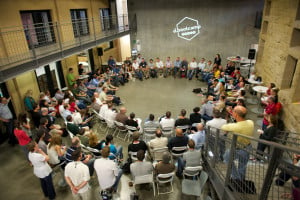
Founded in 2003, the Hasso-Plattner Institute of Design, known as the d.school, is still exploring how exactly it fits into the larger Stanford community, according to those who regularly utilize the school.
The core idea of the d.school, according to d.school Executive Director Sarah Stein Greenberg, is based on its human-centered approach. More and more classes across Stanford are beginning to employ “Design Thinking,” a user-friendly methodology of solving the world’s problems, brought to life with stages of empathy, ideation and prototyping, and which focuses strongly on the user.
“You need to understand and empathize with the users who you’re designing for before you develop the business type of solution,” Greenberg said. “Often people start with new technology, or an idea, but it’s not until later that you do any piloting to find out whether that idea is useful. Design thinking flips that on its head — we need to understand what matters to the people we’re designing for.”
Recently, the d.school employed eight “Experience Assistants,” or EAs, as faces which people can associate with the d.school and reach out to with any questions. These EAs are a diverse group of students with previous d.school experience who are interested in passing along the lessons they’ve learned to others.
One of these EAs, Alex Scully B.A. ’13 M.A. ’14, came to Stanford as an undergraduate on the pre-medical track before she discovered the d.school.
“I realized that I wanted to be a doctor because I wanted to help people, and I realized I couldn’t help people until I knew what they were really about,” she said.
Following this realization, Scully decided to pursue psychology and sociology and began exploring the d.school more closely.
“I had learned so much about the intricacies of people, and that’s who we were designing for,” she added.
The d.school and Design Thinking have also manifested themselves in students’ extracurricular experiences.
Elizabeth Woodson ’15, the president of the ASSU, credits Design Thinking for her successful campaign last year. She began with a simple question: What does Stanford need? But instead of attempting to come up with the answer herself, she used a key tenet of Design Thinking — empathy — and posed that same question to the student body.
“We knocked on doors and asked everyone ‘What do you think Stanford needs?’ and we got a huge range of answers, but started to see some really important themes that we built our campaign around,” Woodson said. After her win, she noted, “it was really interesting to see that the empathy had paid off.”
Though the d.school can sometimes seem graduate-student-centric for some undergraduates, as three-quarters of the students involved are graduate students, there are many opportunities for interested undergraduates to get involved, according to Greenberg.
Pop-Up Classes are offered in the winter and spring quarters, which are brief forays into the world of the d.school and Design Thinking. These classes meet a few times a quarter for a condensed amount of time, and many are open to students of all years and majors to get a taste of Design Thinking and design methodology. There are also events held at the d.school like Pitch Night, in the fall and winter, an open house where students present their projects.
“If undergrads want more exposure to Design Thinking, one thing they can do is take a product design class; for example, ME101 involves Design Thinking and hands-on making skills,” Greenberg said.
For freshmen and sophomores, there is also the popular “Designing Your Stanford” class, or, for juniors and seniors, “Designing Your Life”–two-unit workshops highlighting aspects of the design process.
The d.school does not grant degrees of its own. Rather, in keeping with its interdisciplinary style, it simply serves as a place to build design-related skills to use in other fields of study.
“There are assets of Design Thinking that are very broadly applicable,” Greenberg said. “There’s interests from all different places. For example, there’s a woman working on the intersection between law and design, and there was also a class taught by a med school professor and designer about redesigning the neonatal center at the hospital. That’s where design can play an important role, because these are profoundly human experiences.”
Scully was quick to add that it’s not about what someone is studying, but rather a curiosity and interest to learn more, and to apply that knowledge in a different manner.
“If you’re introverted, extroverted, a social scientist or a biomedical engineer, I would recommend taking a design class,” Scully said.
“I think [not taking a class at the d.school] is like not ever climbing Hoover Tower, or not ever walking the Dish, or not ever taking a technology class, or something like that,” Woodson said.
Contact Leela Srinivasan at [email protected].